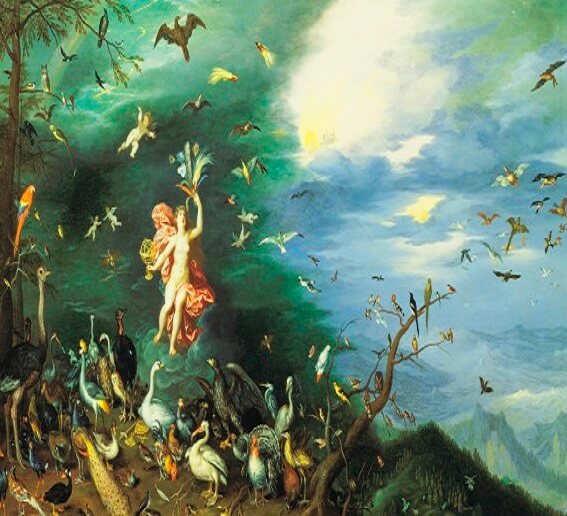
Telchines And Heliadae

In Greek mythology, the Telkhines were the original inhabitants of the island of Rhodes, and were known in Crete and Cyprus.
Their parents were either Pontus and Gaia, or Tartarus and Nemesis, or else they were born from the blood of castrated Uranus along with the Erinyes. In another story there were nine Telkhines, children of Thalassa and Pontus; they had flippers instead of hands and the heads of dogs and were known as fish children.
They were regarded as excellent metallurgists: various accounts state that they were skilled metal workers in brass and iron, and made a trident for Poseidon and a sickle for Cronus, both ceremonial weapons. By some accounts, their children were highly worshiped as gods in the ancient Rhodes towns of Ialysos, Kamiros and Lindos.
The Telkhines were entrusted by Rhea with the upbringing of Poseidon, which they accomplished with the aid of Capheira, one of Oceanus' daughters. Another version says that Rhea accompanied them to Crete from Rhodes, where nine of the Telchines, known as the Curetes, were selected to bring up Zeus.
The Telkhines were associated and sometimes confused with the Cyclopes, Dactyls and Curetes.
They were believed to bring about hailstorms, snow, and rain at will, to assume any shape they pleased, and produced a substance poisonous to living things.
The gods (Zeus, Poseidon or Apollo) eventually killed them because they began to use magic for malignant purposes; particularly, they produced a mixture of Stygian water and sulfur, which killed animals and plants (according to Nonnus, they did so as a revenge for being driven out of Rhodes by the Heliadae - see below).
Accounts vary on how exactly they were destroyed: by flood, or Zeus's thunderbolt, or Poseidon's trident, or else Apollo assumed the shape of a wolf to kill them. They apparently lost one of the titanomachias, the battles between the gods and the Titans.
Names
The following individual names are attested in various sources: \n \n
Aktaios (Actaeus), Argyron, Atabyrius, Chalcon, Chryson, Damnameneus, Damon or Demonax, Hormenius or Ormenos, Lykos (Lycus) or Lyktos, Megalesius,
Mylas, Nicon, Simon, Skelmis
Known female Telkhines were Makelo, Dexithea (one of Damon's daughters) and probably Lysagora (the attesting text is severely damaged). Ovid in his Ibis mentions that Makelo, like the other Telkhines, was killed with a thunderbolt; according to Callimachus and Nonnus, however, Makelo was the only one to be spared.
According to Bacchylides, the survivor is Dexithea. Bacchylides also mentions that Dexithea later had a son Euxanthios by Minos. This Euxanthios is also known from Pindar's works.
In Greek mythology, the Heliadae were the seven sons of Helios and Rhode and grandsons of Poseidon, brothers to Electryone. They were Ochimus, Cercaphus, Macareus or Macar, Actis, Tenages, Triopas, and Candalus (Nonnus adds Auges and Thrinax).
They were expert astrologers and seafarers, and were the first to introduce sacrifices to Athena at Rhodes. They also drove the Telchines out of Rhodes.
Tenages was the most highly endowed of the Heliadae, and was eventually killed by Macareus, Candalus, Triopas and Actis who were jealous of his skills at science.
As soon as their crime was discovered, the four had to escape from Rhodes: Macareus fled to Lesbos, Candalus to Cos, Triopas to Caria, and Actis to Egypt.
Ochimus and Cercaphus, who stayed aside from the crime, remained at the island and founded the city of Achaea (in the territory of modern Ialysos). Ochimus, the eldest of the brothers, seized control over the island; Cercaphus married Ochimus' daughter and succeeded to the power.
The three sons of Cercaphus, Lindus, Ialusus and Camirus, were founders and eponyms of the cities Lindos, Ialysos and Kameiros respectively.
Sources
[1] "PaleoThea"
Tzetzes on Theogony 80
Eustathius on Homer, p. 771
Diodorus Siculus, Library of History 5. 55. 5 ff
Strabo, Geography 14. 2
Callimachus, Hymn 4 to Delos 28 ff
Strabo, Geography 10. 3. 19
Strabo, Geography 10. 3. 7
Diodorus Siculus, Library of History, 5. 55
Ovid, Metamorphoses 7. 365 ff
Strabo, Geography 14. 2. 7
Nonnus, Dionysiaca 14. 36 ff
Pindar, Paean 5
Nonnus, Dionysiaca 18. 35
Servius' on Aeneid IV. 377
Eustathius on Homer p. 772
Nonnus, Dionysiaca 14. 36
Tzetzes' commentary on Theogony 80
Stephanus of Byzantium s. v. Ataburon
Hesychius s. v. Mylas
Callimachus, Aitia Fragment 75
Bacchylides, Fragment 1
Ovid, Ibis, 475
Callimachus, Aitia Fragment 3. 1
Confirmed by the account of Pseudo-Apollodorus, Bibliotheca 3. 1. 2
Nonnus, Dionysiaca, 14. 44
Diodorus Siculus, Library of History 5.56; Pindar, Odes Olympian 7.3
Diodorus Siculus, Library of History 5.57.2
Diodorus Siculus, Library of History 5.57.6
Pindar, Odes Olympian 7.3 sqq
Our Mobile Application
Check out Our Mobile Application "Ancient Greece Reloaded"
